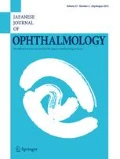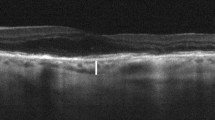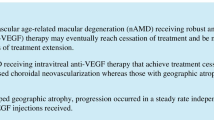Abstract
Purpose
To assess intravitreal bevacizumab (IVB) for choroidal neovascularization (CNV) secondary to age-related macular degeneration (AMD) in Japanese patients.
Methods
Forty-seven patients treated with IVB for newly diagnosed subfoveal or juxtafoveal CNV (predominantly classic CNV, 15 eyes; minimally classic CNV, 11 eyes; occult CNV, 21 eyes) secondary to AMD and followed for more than 12 months were reviewed retrospectively. IVB (1 mg) was injected via the pars plana. Additional IVB or photodynamic therapy was administered for either persistent or recurrent exudation. The main outcome measurements were best-corrected visual acuity (BCVA), number of injections, and treatment other than bevacizumab.
Results
The mean baseline visual acuity (VA) was 0.38 [logarithm of the minimum angle of resolution (logMAR), 0.42] and final VA was 0.42 (logMAR, 0.38). During 12 months, bevacizumab was injected a mean of 3.4 times. Eight eyes received additional treatment. Up until 12 months, the mean BCVA with predominantly classic CNV increased, whereas the BCVA with minimally classic or occult with no classic CNV stabilized. The mean number of injections for predominantly classic CNV was 2.5, that for minimally classic CNV was 4.9, and that for occult with no classic CNV was 3.3.
Conclusions
IVB was especially effective for predominantly classic CNV, but CNV with subretinal pigment epithelial lesions might recur or enlarge despite additional IVB.
Similar content being viewed by others
References
Ferris FL 3rd, Fine SL, Hyman L. Age-related macular degeneration and blindness due to neovascular maculopathy. Arch Ophthalmol 1984;102:1640–1642.
Kliffen M, Sharma HS, Mooy CM, et al. Increased expression of angiogenic growth factors in age-related maculopathy. Br J Ophthalmol 1997;81:154–162.
Ferrara N, Davis-Smyth T. The biology of vascular endothelial growth factor. Endocr Rev 1997;18:4–25.
Gonzales CR; VEGF Inhibition Study in Ocular Neovascularization (V.I.S.I.O.N.) Clinical Trial Group. Enhanced efficacy associated with early treatment of neovascular age-related macular degeneration with pegaptanib sodium: an exploratory analysis. Retina 2005;25:815–827.
Gragoudas ES, Adamis AP, Cunningham ET Jr, et al. VEGF Inhibition Study in Ocular Neovascularization Clinical Trial Group. Pegaptanib for neovascular age-related macular degeneration. N Engl J Med 2004;351:2805–2816.
Rosenfeld PJ, Brown DM, Heier JS, et al.; MARINA Study Group. Ranibizumab for neovascular age-related macular degeneration. N Engl J Med 2006;355:1419–1431.
Regillo CD, Brown DM, Abraham P, et al. Randomized, doublemasked, sham-controlled trial of ranibizumab for neovascular agerelated macular degeneration: PIER Study year 1. Am J Ophthalmol 2008;145:239–248.
Kaiser PK, Brown DM, Zhang K, et al. Ranibizumab for predominantly classic neovascular age-related macular degeneration: subgroup analysis of first-year ANCHOR results. Am J Ophthalmol 2007;144:850–857.
Fung AE, Lalwani GA, Rosenfeld PJ, et al. An optical coherence tomography-guided, variable dosing regimen with intravitreal ranibizumab (Lucentis) for neovascular age-related macular degeneration. Am J Ophthalmol 2007;143:566–583.
Rosenfeld PJ, Moshfeghi AA, Puliafito CA. Optical coherence tomography findings after an intravitreal injection of bevacizumab (Avastin) for neovascular age-related macular degeneration. Ophthalmic Surg Lasers Imaging 2005;36:331–335.
Bashshur ZF, Haddad ZA, Schakal A, et al. Intravitreal bevacizumab for treatment of neovascular age-related macular degeneration: a one-year prospective study. Am J Ophthalmol 2008;145:249–256.
Cleary CA, Jungkim S, Ravikumar K, et al. Intravitreal bevacizumab in the treatment of neovascular age-related macular degeneration, 6- and 9-month results. Eye 2008;22:82–86.
Emerson MV, Lauer AK, Flaxel CJ, et al. Intravitreal bevacizumab (Avastin) treatment of neovascular age-related macular degeneration. Retina 2007;27:439–444.
Spaide RF, Laud K, Fine HF, et al. Intravitreal bevacizumab treatment of choroidal neovascularization secondary to age-related macular degeneration. Retina 2006;26:383–390.
Rich RM, Rosenfeld PJ, Puliafito CA, et al. Short-term safety and efficacy of intravitreal bevacizumab (Avastin) for neovascular agerelated macular degeneration. Retina 2006;26:495–511.
Gotoh N, Yamada R, Hiratani H, et al. No association between complement factor H gene polymorphism and exudative agerelated macular degeneration in Japanese. Hum Genet 2006:139–143.
Japanese Age-Related Macular Degeneration Trial (JAT) Study Group. Japanese age-related macular degeneration trial: 1-year results of photodynamic therapy with verteporfin in Japanese patients with subfoveal choroidal neovascularization secondary to age-related macular degeneration. Am J Ophthalmol 2003;136:1049–1061.
Shima C, Sakaguchi H, Gomi F, et al. Complications in patients after intravitreal injection of bevacizumab. Acta Ophthalmol 2008;86:372–376.
Gomi F, Sawa M, Sakaguchi H, et al. Efficacy of intravitreal bevacizumab for polypoidal choroidal vasculopathy. Br J Ophthalmol 2008;92:70–73.
Japanese Age-Related Macular Degeneration Trial (JAT) Study Group. Photodynamic therapy with verteporfin in Japanese patients with subfoveal choroidal neovascularization secondary to age-related macular degeneration (AMD): results of the Japanese AMD Trial (JAT) extension. Jpn J Ophthalmol 2008;52:99–107.
Gomi F, Ohji M, Sayanagi K, et al. One-year outcomes of photodynamic therapy in age-related macular degeneration and polypoidal choroidal vasculopathy in Japanese patients. Ophthalmology. 2008;115:141–146.
Arias L, Caminal JM, Casas L, et al. A study comparing two protocols of treatment with intravitreal bevacizumab (Avastin) for neovascular age-related macular degeneration. Br J Ophthalmol 2008;92:1636–1641.
Author information
Authors and Affiliations
Corresponding author
About this article
Cite this article
Suzuki, M., Gomi, F., Sawa, M. et al. Bevacizumab treatment for choroidal neovascularization due to age-related macular degeneration in Japanese patients. Jpn J Ophthalmol 54, 124–128 (2010). https://doi.org/10.1007/s10384-009-0775-3
Received:
Accepted:
Published:
Issue Date:
DOI: https://doi.org/10.1007/s10384-009-0775-3




